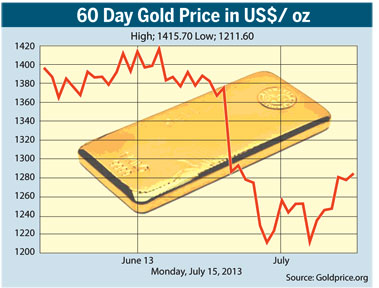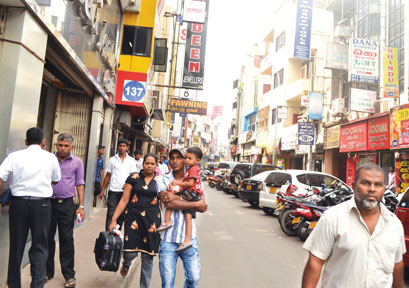Drop in gold prices - no threat to banking system
By Gamini Warushamana
Gold sovereigns the easiest and safest way of lending for banks and
vice versa. Gold is considered an asset with lowest or zero risk. Over
the past six years, the price of gold in the international market has
shown a continuous increase. With this gold boom banks lent money
heavily on gold mortgages and there was intense competition among banks.
The banks lent 75-80 percent of the value of gold.
 With the sharp price drop in the past few months the banking sector
faced a crisis because it is now cheaper for borrowers to buy new gold
jewellery rather than redeem their mortgage by paying interest. With the sharp price drop in the past few months the banking sector
faced a crisis because it is now cheaper for borrowers to buy new gold
jewellery rather than redeem their mortgage by paying interest.
CEO of the Seylan Bank, Kapila Ariyaratne said that the risk is
dependent on the level of exposure of the bank. If the gold mortgage
backed lending is high, the risk is high.
However, banks manage their debt portfolio carefully and, therefore,
the risk is manageable.
The advantage of gold as a collateral is that it can be sold easily
without long legal procedures.
There is always a demand for gold and most of the borrowers redeem
their jewellery because they have strong bonds with it, it may be their
wedding ring or necklace or a gift from someone special.
 |
|
K. K. Radhakrishnan |
Therefore, the crisis is not serious and is manageable, he said.
According to reliable information several banks have felt a severe
impact as their gold backed lending was high. However, it will not lead
to a crisis in the banking sector or the individual banks.
Banks have already taken action to reduce risks. There is no capital
loss and only the income of the banks hasbeen affected, an official of a
commercial bank said.
The president of the Sri Lanka Jewellers Association, K.
Radhakrishnan said that the price of gold in the Colombo market has
dropped to Rs. 43,416 a sovereign. With the newly enforced 10 percent
tax the price is Rs. 47,757.
During the boom, the price ranged between Rs. 57,000 to 58,000. As a
result demand for gold in the Colombo market declined around 40 percent
and demand is now picking up. The government tax may be to protect the
banking sector but it will slow the recovery of the market, he said.
Radhakrishnan said that banks will lose over Rs.13,000 per gold
sovereign under the new price structure. We cannot predict future price
fluctuations and today the price is Rs. 500 higher compared to
yesterday's price and we regularly monitor price movement, he said.
He expects the 10 percent tax to be temporary and said that the
government has flexible policies regarding this industry because it is
one of the largest tax bases of the government.
Gold prices increased steadily from late 2007. Over the past ten
years the price increase in US dollar terms, was 13 percent. Over this
period the highest annual increase, a 30 percent increase was reported
in 2007 and in 2008, a 5.6 percent increase or the lowest had been
reported.
Prices have dropped since 2010 and the annual price increase in 2010,
2011 and 2012 was 27.1 percent, 10.1 percent and 7 percent. In the first
half of 2013 prices had fallen by 13 percent and the trend continues.
Analysts said that price fluctuations have clearly shown a declining
trend from 2010 and, therefore, it is not surprising. Banks and
financial institutions are always cautious of market trends and,
therefore, there is no need for panic.
However, the recent price decline is sharp and within 30 days the
price of gold has dropped by $ 92.40. During the past six months the
price dropped by $ 392.80. There are several reasons for the fluctuation
of gold prices over the past few years.
The global economic crisis in 2008 pushed gold prices upwards because
gold was the safe haven for investors compared to the falling value of
hard currencies and stocks.
 |
|
Gold jewellery market
in Sea Street, Colombo |
During the global economic crisis, many countries sought to increase
their gold holdings as they did not wish to keep too much of their
reserves in hard currency that could lose value.
Therefore, not only people and corporate investors, even Central
Banks too increased their gold purchases. According to the World Gold
Council, Central Banks' gold purchases rose to a 48-year high and
represented 12 percent of global demand, last year.
Economic analysts said that signs of recovery in the global economy,
especially the positive outlook of the US economy and the strengthening
of the US dollar has reversed the trend.
It is an investment decision to hold either gold or hard currencies
and analysts said that choice has been changing to hard currencies and
stocks. It is doubtful how far the fall will continue. If the recovery
of the global economy continues, especially in the US, EU and Japan,
gold price will continue to fall or remain low, they said. On the other
hand people tend to invest in gold at a time inflation is high.
Analysts said that recovery in the global economy is doubtful and
according to the latest IMF forecast the global economy is growing more
slowly than expected.
With increasing risks especially in emerging markets, global growth
is now projected at 3.1 for 2013 and 3.8 percent for 2014, a downward
revision of 1/4 percentage point compared with the April 2013 forecast.
Analysts point out that gold was about $850 an ounce before the
global economic crisis in 2008 and therefore there is little reason to
expect it to fall further. Last week the international market price was
over Rs.1,200 and at the peak in 2012 the price was over $ 1,650 an
ounce. |


